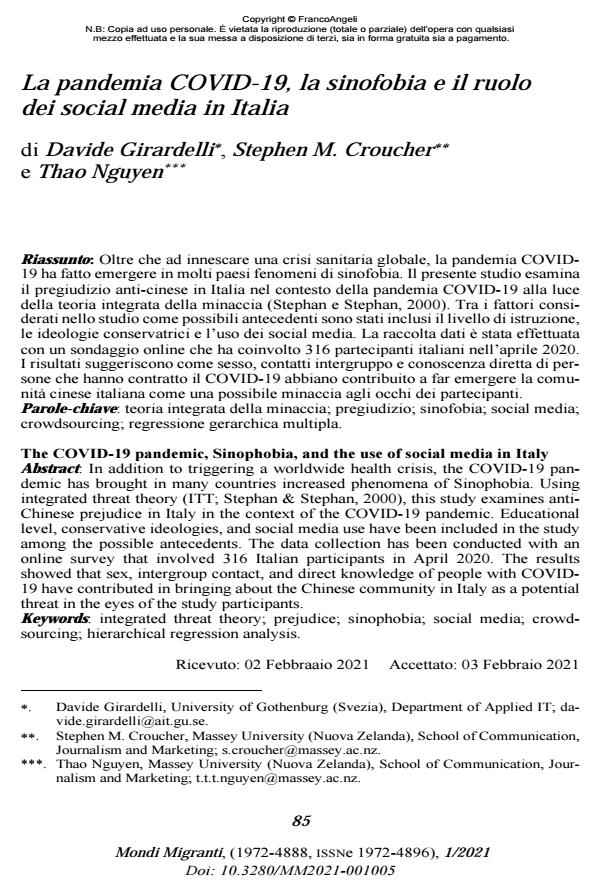The COVID-19 pandemic, Sinophobia, and the use of social media in Italy
Journal title MONDI MIGRANTI
Author/s Davide Girardelli, Stephen M. Croucher, Thao Nguyen
Publishing Year 2021 Issue 2021/1
Language Italian Pages 20 P. 85-104 File size 254 KB
DOI 10.3280/MM2021-001005
DOI is like a bar code for intellectual property: to have more infomation
click here
Below, you can see the article first page
If you want to buy this article in PDF format, you can do it, following the instructions to buy download credits

FrancoAngeli is member of Publishers International Linking Association, Inc (PILA), a not-for-profit association which run the CrossRef service enabling links to and from online scholarly content.
In addition to triggering a worldwide health crisis, the COVID-19 pandemic has brought in many countries increased phenomena of Sinophobia. Using integrated threat theory (ITT; Stephan & Stephan, 2000), this study examines anti-Chinese prejudice in Italy in the context of the COVID-19 pandemic. Educational level, conservative ideologies, and social media use have been included in the study among the possible antecedents. The data collection has been conducted with an online survey that involved 316 Italian participants in April 2020. The results showed that sex, intergroup contact, and direct knowledge of people with COVID-19 have contributed in bringing about the Chinese community in Italy as a poten-tial threat in the eyes of the study participants.
Keywords: Integrated threat theory; prejudice; sinophobia; social media; crowd-sourcing; hierarchical regression analysis
- Pandémie en Italie : une analyse sur plusieurs niveaux Giuseppe Bettoni, in Hérodote /2021 pp.181
DOI: 10.3917/her.183.0181 - COVID-19 fear and ethnocentrism in the global south: A cross-cultural analysis Stephen M. Croucher, Doug Ashwell, Mohan Dutta, Jo Cullinane, Shawn Condon, Anthony Spencer, in International Journal of Intercultural Relations 102146/2025 pp.102146
DOI: 10.1016/j.ijintrel.2025.102146 - Gli atteggiamenti nei confronti dell'immigrazione prima e dopo la pandemia Covid-19 in 13 paesi europei. Uno studio esplicativo Veronica Riniolo, Vera Lomazzi, in MONDI MIGRANTI 1/2025 pp.189
DOI: 10.3280/MM2025-001010 - COVID-19 Prejudice Towards Afro-Brazilians Stephen Croucher, Thao Nguyen, Doug Ashwell, Anthony Spencer, Tatiana Permyakova, Oscar Gomez, in Journal of Intercultural Communication Research /2022 pp.383
DOI: 10.1080/17475759.2021.1957702 - Introduction: Migrants and Migration in the Eco-Pan-Syndemic Era Francesco Della Puppa, Fabio Perocco, in Two Homelands /2022
DOI: 10.3986/dd2022.2.01
Davide Girardelli, Stephen M. Croucher, Thao Nguyen, La pandemia COVID-19, la sinofobia e il ruolo dei social media in Italia in "MONDI MIGRANTI" 1/2021, pp 85-104, DOI: 10.3280/MM2021-001005